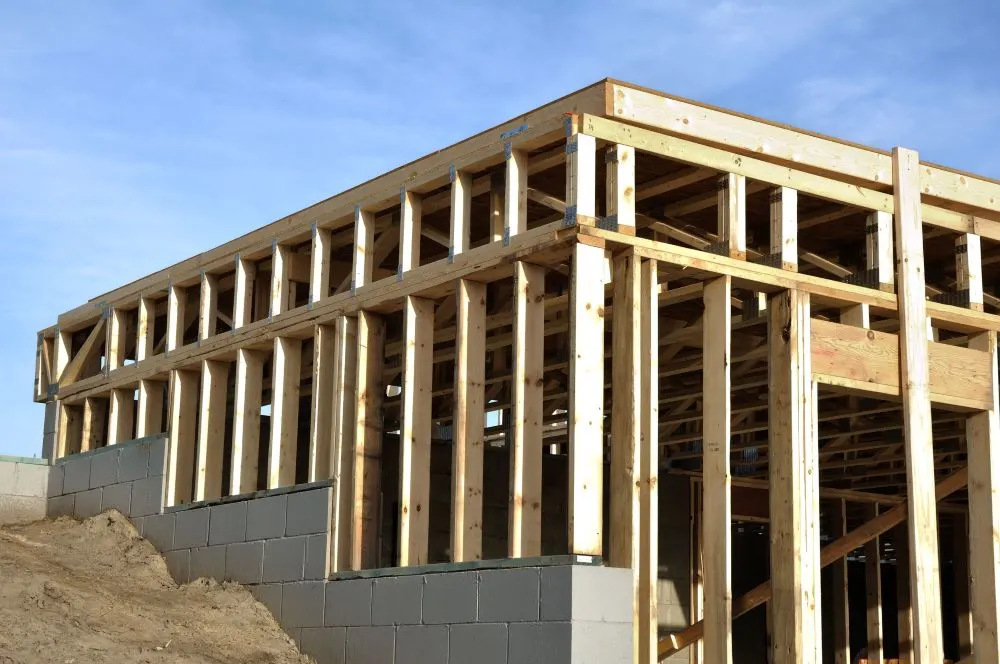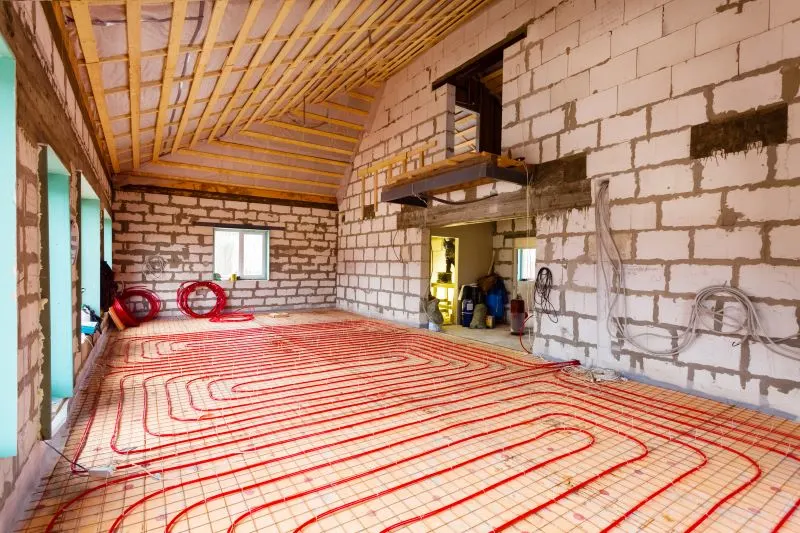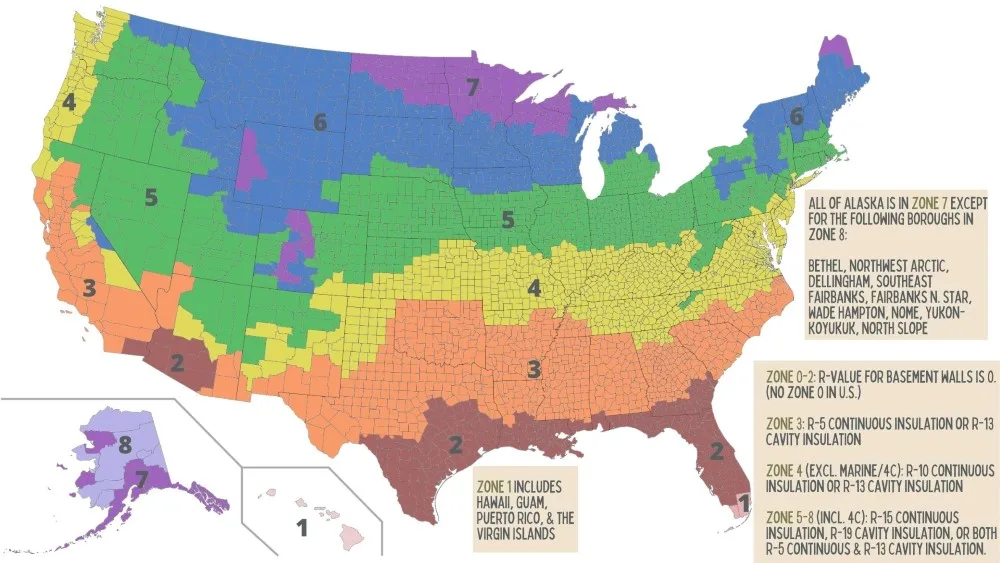Unfinished Basement Insulation Code
There is undeniably a complicated bunch of data surrounding the coding for insulation. The instructions, provisions, as well as exceptions involved arrive a scrap of a headache to accept to sort out through.
Well, hither, you will discover the information alongside a linear layout for repose of purpose. I will highlight as well as talk over the relevant terminology and sections of the edifice code for insulating unfinished basements together with embrace the specific requirements yous’ll involve to comply with to avoid insulating your basement.

An unfinished basement is unconditioned too should live insulated. There are specific R-values for insulating the thermal envelope based on climate zones. To be exempt from this, a basement must follow all necessary steps for properly sealing the thermal envelope in addition to protecting the house’s conditioned spaces.
Defining a Basement Wall (together with Other Important Terms)
The of import terms regarding insulation inwards the International Residential Code (IRC) are found in Section N1101.half-dozen (R202). It is beneficial to know these price equally it aid you lot to navigate which regulations employ to unfinished basements.
Basement Wall
A basement wall is defined every bit enclosing conditioned space, with one-half or more than of the wall sitting below course.

Conditioned Space
Conditioned space is within the thermal envelope of a building and is straight or indirectly heated or cooled.
A space is indirectly heated or cooled through communication amongst a conditioned space through openings together with uninsulated ceilings, walls, doors, ducts, pipes, in addition to heating or cooling systems.

R-Value (Thermal Resistance)
Section N1101.half-dozen (R202) (IRC) defines R-value (thermal resistance) every bit:
“The inverse of the fourth dimension rate of estrus flow through a body from 1 of its bounding surfaces to the other surface for a unit temperature deviation between the 2 surfaces, nether steady land atmospheric condition, per unit area (h ten ft2 x *F/BTU) [m2 x thou)/due west].”
In a less mathematical explanation, R-value or thermal resistance refers to the thickness of insulation textile as well as its insulating outcome. The higher the R-value of insulation, the more than it prevents the transfer of heat.
Required Minimum Basement Insulation
Climate Zones
The minimum requirements for insulation, or R-values, depend on the climate zone you lot are located inward.
There are three category designations with the eight climate zones that bring up to moisture divisions:
- A: moist areas.
- B: dry areas.
- C: marine areas.
You tin discover out what zone as well as wet division your country is according to the figure in addition to tables inwards Section N1101.7 of the IRC.
Minimum Requirements for R-Values
Table N1102.ane.3 (R402.1.3) of the IRC gives the minimum requirements for R-values for basement walls according to climate zones. This is represented in the IRC by values for continuous insulation (ci) or cavity insulation.
Continuous insulation is installed on the interior and the outside surface of the basement walls (y'all tin can read more than on exterior insulation inward Reasons Why The Basement is Warmer Than the Rest of the House), while cavity insulation is the type that is installed betwixt 2 parts of a wall.

- Zone 0-two: R-value for basement walls is 0. (No Zone 0 inwards U.southward.).
- Zone 3: R-five continuous insulation or R-thirteen cavity insulation.
- Zone four (excluding marine/4C): R-ten continuous insulation or R-xiii cavity insulation.
- Zone 5-viii (including 4C): R-xv continuous insulation, R-19 cavity insulation, or both R-v continuous together with R-13 cavity insulation at once.
Installation Instructions
Insulation must be installed starting from the summit of the basement walls too extending ten ft below the form grade or to the basement flooring, depending on which distance is less.
When Is the Insulation Not Required?
Section N1102.two.8 (R402.ii.8) makes exceptions from the touchstone R-value for basements amongst unconditioned walls. But yous must run across every 1 of the following requirements, or in that location is no exception.
i. Insulating the Floor Above
The flooring above the basement (including the step stringer) must live properly insulated per the general in addition to specific requirements for floors inwards Table N1102.ane.three (R402.1.three) in addition to in Section N1102.two.vii (R402.2.7).
Table N1102.one.3 (R402.ane.three) shows R-values for floors:
- Zone i-2: R-xiii.
- Zone three-iv (except 4C): R-nineteen.
- Zone five-vi (including 4C): R-thirty.
- Zone 7-eight: R-38.
Section N1102.ii.seven (R402.2.7) of the IRC states that flooring cavity insulation must comply with i of the next:
- Insulation must live installed to be inward permanent contact with the underside of the subfloor as per manufacturer teaching to achieve the minimum R-value or fill up the cavity infinite.
- Floor framing cavity insulation tin live in contact with the height of the sheathing that separates the cavity from the unconditioned basement. The insulation must span the perimeter floor framing fellow member (which must live sealed) from bottom to superlative.
- Combined cavity in addition to continuous insulation volition collectively encounter the required R-value. Cavity insulation must be installed inward contact with the acme of continuous insulation, which must live installed on the underside of the framing that separates the cavity from the basement.
This protects against the central of rut and cold betwixt the unconditioned, unfinished basement as well as the conditioned surface area above. The insulation helps maintain the temperature residuum inwards your domicile when an unconditioned basement would constantly cool or heat it.
2. Exposed Surfaces
There must live no uninsulated surfaces on ducts in addition to heating equipment (hot water or hydronic) exposed to your basement.
For ducting, having no protective insulation volition let the central of heat in addition to cold into too out of the ducts.
Having exposed heating equipment volition let the transfer of oestrus from those appliances into the basement. This agency that y'all’ll accept to pay higher utility bills for the extra free energy to compensate for estrus loss as well as you lot might terminate upward with an excessively hot basement, even inward winter.
iii. Diffusers
You may non take any HVAC render or furnish diffusers for the basement.
Diffusers permit air to get in (supply) or go (return) a room through the ventilation organization.
In an unfinished basement, yous volition live supplying conditioned air into a room that isn’t sealed to preserve conditioning, or y'all volition live allowing unconditioned air to enter your HVAC arrangement.
four. Protecting Conditioned Spaces
You must protect your conditioned spaces by installing insulation on walls around the stairs as well as walls adjacent to conditioned spaces, according to the instructions inward Section N1102.1.three together with Section N1102.two.
R-values for Wood Frame Walls
- Zone one-2:
- R-thirteen cavity.
- Or R-0 cavity + R-x continuous.
- Zone 3:
- R-20 cavity.
- Or R-xiii cavity + R-v continuous.
- Or R-0 cavity + R-fifteen continuous.
- Zone 4-five:
- R-twenty cavity.
- Or R-xiii cavity + R-10 continuous.
- Or R-0 cavity + R-xv continuous.
- Zone vi-viii:
- R-20 cavity + R-v continuous.
- Or R-13 cavity + R-x continuous.
- Or R-0 cavity + R-20 continuous.
R-Values for Mass Walls
For volume walls, in that location are ii R-values. The second refers to the value for situations when more than than half of the insulation is on the interior of a bulk wall.
- Zone one: R-3/R-4.
- Zone two: R-four/R-vi.
- Zone three-iv (excluding 4C): R-eight/R-xiii.
- Zone 5 (including 4C): R-13/R-17.
- Zone 6: R-15/R-20.
- Zone seven-viii: R-19/R-21.
Mass walls must too take a heat capacity of at least half-dozen Btu/fttwo× °F (123 kJ/one thousand2× G) if they are a element of the thermal envelope, equally per Section N1102.ii.five (R402.2.v) of the IRC.
5. Doors to Conditioned Spaces
The doors that open to conditioned spaces must live properly insulated (Section N1102.i.iii too Section N1102.two) together with weatherstripped (Section N1102.4).
This is done to save the thermal envelope of your house as well as keep conditioned air inside.
Door Insulation
Section N1102.ii.four of the IRC states that doors betwixt conditioned too unconditioned spaces must be insulated to jibe the R-value of the ceiling or wall in which they are installed. This way that yous volition follow the floor too ceiling R-values constitute inward Table N1102.i.iii (R402.1.iii). For the basement, yous will live next the R-value of the flooring in a higher place.
Door Sealing
According to Section N1102.iv.i.1 (R402.iv.one.ane), the components of the thermal envelope (including doors between conditioned spaces together with unconditioned basements) must be installed every bit per manufacturer instructions together with Table N1102.four.1.ane (R402.four.ane.i).
To comply with the code and foreclose the central of conditioned and unconditioned air, y'all must seal the spaces about the door jambs.
Sealing and insulating the basement door will obviously touch on the ventilation inwards the basement, then only brand sure that y'all account for this to foreclose moisture construct-upward in the basement. This is specially of import if your basement has no windows. Please banker's bill that patch not insulating your basement tin, inwards this mode, increment humidity in your basement, insulating it volition non trim humidity.
6. Thermal Envelope
The house’s thermal envelope that separates the basement from conditioned spaces must comply amongst Section N1102.four of the IRC.
Section N1102.iv.1 (IRC) states that the thermal envelope must comply with Sections N1102.iv.1.one to N1102.four.1.3. Section N1102.4.ane.i (R402.4.1.one) requires that the thermal envelope components comply alongside manufacturer instructions in addition to Table N1102.iv.i.1 (R402.four.i.1).
There must live a continuous air barrier with sealed joints or breaks, as well as no air-permeable insulation can live used every bit function of the sealing. There must also be contraction too expansion allowance for sealing between dissimilar material for airtightness.
Section N1102.four.one.two (R402.four.i.2) too Section N1102.iv.i.three (R402.4.ane.3) embrace air leakage testing too rates. Your home must be tested for air leakage, which, in code-compliant dwelling house units, should be a maximum of v.0 air changes per hour inward Zone one-two, as well as 3.0 inwards Zone iii-8. It should never go past 5.0 air changes/60 minutes or 0.28 CFM of the enclosure surface area.
If yous design on heating your unfinished basement, and so you should at to the lowest degree insulate it properly, beyond what is code-required. It mightiness toll you about cash outlay, but it will brand the heating procedure efficient together with effective.
Insulation is simply every bit important inward summer as it is inwards winter.
Sources
https://aerolite.org.za/ceiling-insulation-r-value/
https://www.bradfordinsulation.com.au/data-eye/how-insulation-plant/what-is-r-value
https://basc.pnnl.gov/images/iecc-climate-zone-map
https://www.greenbuildingadvisor.com/article/all-most-climate-zones
https://buyductings.com/render-air-diffuser/
https://buyductings.com/supply-air-diffuser/



Comments
Post a Comment